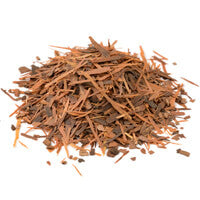 Pau D'Arco is also known as Taheebo and Lapacho. It comes from a large flowering tree that is native to sub-tropical regions of South America. Its Latin name is Handroanthus impetiginosus (sometimes referred to by the synonym Tabebuia avellanedae).
Pau D'Arco is also known as Taheebo and Lapacho. It comes from a large flowering tree that is native to sub-tropical regions of South America. Its Latin name is Handroanthus impetiginosus (sometimes referred to by the synonym Tabebuia avellanedae).
The inner tree bark of Pau D’Arco has been used traditionally by indigenous peoples, including the Incas, as a "cure-all" for wounds, skin diseases, snakebites, fever, malaria, intestinal problems including dysentery, and lung health.
In more recent times, it has been by herbalists as a general tonic, immunostimulant, and adaptogen. It is most used as herbal medicine for the overgrowth of the fungal species Candida in the digestive system.
Scientists have identified two main active compounds in Pau D'Arco. These active compounds are called naphthoquinones; lapachol and beta-lapachone. Pau D’Arco also contains significant amounts of the antioxidant quercetin.
In cell-based assays, these compounds kill some bacteria, fungi, viruses and parasites. They also have anti-inflammatory and antioxidant properties.
Pau D'Arco Extract is most commonly used to help fight off Candida which is an opportunistic fungal pathogen that overgrows when the immune system is compromised.
You may benefit from taking Pau D'Arco if you have an overgrowth of Candida. The main indicator of Candida overgrowth is repeated outbreaks of Candida, such as vaginal thrush, or oral candidiasis.
Byeon SE, Chung JY, Lee YG, Kim BH, Kim KH, Cho JY. In vitro and in vivo anti-inflammatory effects of taheebo, a water extract from the inner bark of Tabebuia avellanedae. J Ethnopharmacol. 2008;119:145-152.
Gomez Castellanos JR, Prieto JM, Heinrich M. Red Lapacho (Tabebuia impetiginosa) -- a global ethnopharmacological commodity? J Ethnopharmacol. 2009;121:1-13.

Foundational health is important because it addresses all parts of our bodies, inside and out. It’s a way of addressing problems before they become problems. We are sometimes completely unaware of something ‘bubbling away’ until illness or diseas...

Astragalus Root Extract Background & Benefits Astragalus is one of the most widely used Chinese traditional medicines. It is also known as huang qi or milk vetch. There are over 2,000 different species of Astragalus. The species Astragalus membranaceus is used in dietary supplements. Astraga...
Shipping calculated at checkout